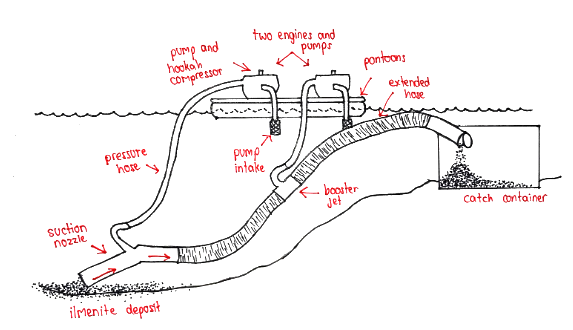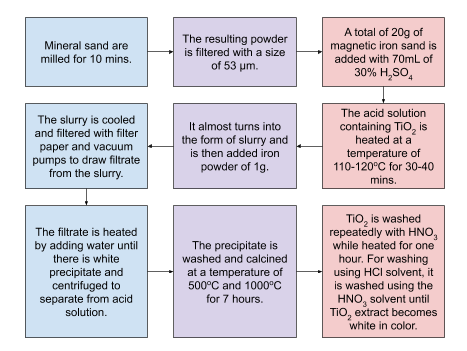MINING PROPOSAL FOR THE CONSTRUCTION AND OPERATION OF THE ROCK BOTTOM AND ILMENITE PROJECT MINE SITE
Introduction: a Reformation of Mining and Its Proposal
We are very pleased to present this Eco-friendly Mining Proposal for the Construction and Operation of the Rock Bottom and Ilmenite Project Mine Site to the Ministry of Energy and Natural Resources of Quebec. This proposal represents the societal demands of one particular valuable mineral while minimizing the impact on the environment and natural resources. It has come to our attention that there has been a high demand for more ilmenite to be obtained in order to manufacture them into a wide range of products that people buy and use nowadays. Not surprisingly, mining is among human activities with the widest environmental and social impacts. While mining has always been a topic of debate in regards to its environmental, economic, and health/social impacts, it cannot be refuted that this activity is one of the fundaments of our economy and advancement in technology. Mining is a means of extracting resources from nature and utilizing them to fit our narratives and demands. We acknowledge that mining activities do pose a significant problem to both the environment and our health, which is the reason why we have decided to send a proposal regarding our newly-designed and modified eco-friendly mining procedures. The following contents of this report will provide a much deeper insight into the situation and discuss in details about the mineral in question, its future mining site location, the new procedures of the eco-friendly mining in terms of the mining and extracting process, and the conclusion to the closure of the mine.
Chosen Mineral: Ilmenite
Ilmenite is a common accessory mineral in igneous rocks, sediments, and sedimentary rocks in several parts of the world. It is named for its place of discovery at Ilmen Lake in the Ilmen Mountains, Miask in the southern portion of the Ural Mountains of Russia. Significant titanium-bearing ilmenite deposits exist in Western Australia, Canada, China, India, Mozambique, New Zealand, Norway, Ukraine and South Africa. Ilmenite is the primary ore of titanium, along with rutile. Most ilmenite forms during the slow cooling of magma chambers and is concentrated through the process of magmatic segregation. A large underground magma chamber can take centuries to cool. As it cools, crystals of ilmenite will form at a specific temperature. These crystals are heavier than the surrounding melt and sink to the bottom of the magma chamber, forming in a collection of distinct layers of mineral. It is these layers that constitute a rich ore body for titanium miners. Ilmenite also occurs in pegmatites and some metamorphic rocks as well as in the sedimentary rocks that are formed from the weathering and erosion of them.
Ilmenite is a black iron-titanium oxide with a chemical composition of FeTiO3. It is a mineral with a submetallic to metallic luster, possessing a black streak, and is not magnetic. It is usually more durable than other minerals in the igneous rocks which is why the weathering debris produced during the weathering of these rocks is especially rich in ilmenite. Its high specific gravity causes it to become concentrated in placer deposits such as gold, gems, and other heavy minerals.
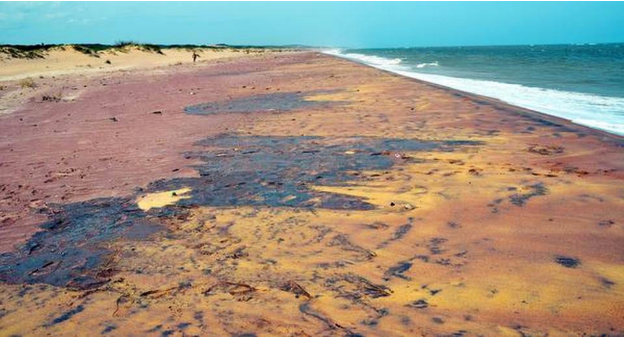
The majority of ilmenite mined worldwide is used to manufacture titanium dioxide, TiO2, an important pigment, whiting, and polishing abrasive. With just a small amount of titanium and certain metals combined together, durable, high-strength, lightweight alloys can be produced. These alloys are used to manufacture a wide variety of high-performance parts and tools such as but not limited to aircraft parts, artificial joints for humans, and sporting equipment (eg. bicycle frames). About 5% of the ilmenite mined is used to produce titanium metal. Some ilmenite can be used to produce synthetic rutile, a form of titanium dioxide that is used to produce white, highly reflective material. The most important use of titanium dioxide is its use as whitings. Whitings are white, highly reflective materials that are grounded to a powder and are used as pigments. These pigments produce a white color and brightness in paint, paper, adhesives, plastics, toothpaste, and even food. Furthermore, titanium dioxide can also be used to make powders with a tightly controlled particle size range, which are used as inexpensive polishing abrasives in a variety of lapidary work that includes rock tumbling, lapping, cabbing, sphere making, and faceting.

Mining Site: Île Sainte-Hélène, Montreal, Quebec, Canada
After thorough and careful consideration, we have come to a consensus that the location of our future mining site will take place near the St. Lawrence River in Île Sainte-Hélène, Quebec. This is due to the fact that the Allard Lake ilmenite deposits lie in the northeastern part of one of the large Precambrian anorthosite masses which are exposed at intervals along the north shore of the St. Lawrence River in Quebec. The ore bodies consist of a series of narrow dikes, irregular lenses, or sill-like bodies that appear to be genetically related to the anorthosite rocks in which they occur. This deposit is the most important ilmenite occurrence in the Allard Lake district and represents the largest body of titanium ore of its type now known in the world. Exploration of this deposit through means of diamond drilling and surface work has shown at least 125,000,000 tons of ore in a tabular body 3,600 feet long and 3,400 feet wide occupied an area of 134 acres (Hammond Allard Lake [Quebec] ilmenite deposits). The deposit ranked first worldwide for its annual production of hemo-ilmenite and second for its mineral reserves. There have been a few mining sites for this mineral in the surrounding vicinity but they have yet to uncover all the resources of ilmenite within the deposits. Hence, our proposal to utilize the area within Île Sainte-Hélène and the area surrounding it in the city of Montreal as our mining site location.

Eco-friendly Mining Proposal
Mining Process
Ilmenite has a high resistance to weathering. When rocks containing ilmenite weather, grains of ilmenite disperse with the sediment. The high specific gravity of these grains causes them to segregate during stream transport and accumulate as heavy mineral sands. These sands are black in color and easily recognized. Black sand prospecting has been a method of finding heavy mineral placer deposits. Most commercially produced ilmenite is recovered by excavating or dredging these sands, which are then processed to remove the heavy mineral grains such as ilmenite, leucoxene, rutile, and zircon. Ilmenite can be mined from both layered intrusive deposits and heavy mineral deposits.
Placer deposit mining is either done as a wet dredge or dry mining operation. The method required depends on the height of the water table where the deposit is found.
- Water dredge mining: An artificial pond is created by digging below the water table. Some operations fill mining ponds with water pumps. A suction bucket wheel attached to a floating dredge is used to remove heavy mineral sediment from the ground. Sediment is then concentrated by passing it through a set of inclined cylindrical trommel screens, as these rotate the material that is too small for processing falls through the screens. The particles that make it this far are then sorted by a spiral concentrator, a chute sorts particles suspended in water based on their size and density. They are flushed down the chute with water. The high-density particles stay closest to the inside of the spiral chutes cross-section with the lower density particles on the outside edge. The sorted sediments are then collected in separate containers the high-density ores separated from the much lower density silicates which make up 98% of the excavated sediment.
- Dry mining: is carried out with conventional earth-moving plants including excavators, scrapers, loaders, and bulldozers. Like wet dredging, the sediments from dry mining also need to be concentrated. This is the same as the above process but is done without water in the spiral concentrator. After the minerals have been concentrated they are put through the feed preparation plant where they are cleaned with attrition scrubbers and subjected to additional gravity concentration before undergoing froth flotation which can remove sulfides or other local unwanted sediments.
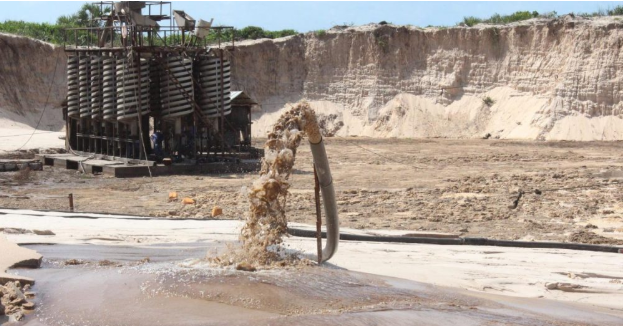
The last step is the dry mill, where a combination of magnetic and electrostatic separation is used to improve the quality of the ore. Titanium’s ores ilmenite and rutile are conductive because of their iron content and can be easily separated from zircon and unwanted silicates. After the dry mill, the ore is ready for export (Titanium Ores – Kyocera SGS Europe).
However, through careful analyses and meticulous discussions, we have come to the conclusion that in order to keep the impacts on the environment minimized, our best interest is to proceed with the first method of water dredge mining. Nonetheless, we are aware of the effects that are left behind during and after the mining procedure which is why we have modified the procedure to fit our agenda and further our mission towards a sustainable and environmentally-friendly future.
Firstly, we would remove the sluice box from the dredge, leaving a floatation system that can support two engines and pumps with a hookah compressor. One of the engines can be used to power a 3-inch special nozzle to the mining equipment that has been modified to allow the option of blowing off lighter gravel and sand to expose the desired minerals which we can then easily obtain the necessary items. This enables us to work our way down to the pay-dirt without having to waste any space or energy on sucking up unnecessary gravel. Once the pay-dirt is exposed, the nozzle will be able to suck it up and transfer it over to a catch container in shallower, slower water which is closer to the bank or on land if the area was close enough. The catch container will be large enough to accumulate the amount of pay-dirt and durable enough to not have any leak or malfunction that would affect the water negatively. As a matter of fact, we offer to construct another layer over the catch container to reinforce the durability and turn it leak-proof. Another suggestion is to fabricate a baffle on the feed into the container so the minerals can be deposited neatly. If there is some distance involved between the mining location and the catch container, we would use the second engine and pump to provide power to a booster jet attached to a second 3-inch hose. This would allow an additional 50 feet, allowing us to closely follow the ground. As a result of all of these adjustments, we would be able to reduce the amount of tailings at the end of the mining process as the whole system was changed to enable blowing the lighter materials away and only sucking up the pay-dirt. The materials needed to be processed out of the catch container are reduced greatly.
Extraction Process
Mineral sand are milled using Laboratory Discmill for 10 minutes, in which the outcome would be the resulting powder being filtered with a size of 53µm. A total of 20 grams of magnetic iron sand is added with 70mL of 30% H2SO4, then the acid solution containing TiO2 is heated at a temperature of 110-120oC 30-40 minutes until it is almost turned into the form of slurry and is added with iron powder of 1g. The slurry is then cooled and filtered with filter paper and vacuum pumps to draw filtrate from the slurry. Afterward, the filtrate is heated by adding water until there are white precipitate and centrifuged to separate from the acid solution. The precipitate is washed and calcined at a temperature of 500oC and 1000oC for 7 hours. To determine the crystal formed of TiO2, the samples are then tested using XRD and XRF.
To increase the content of TiO2, purification is done with HNO3 and HCl. TiO2 extract is washed repeatedly with HNO3 while heated for one hour. For washing using HCl solvent, it is washed using the HNO3 solvent until TiO2 extract becomes white in color (Nurdin, Muhammad, et al.).
Environmental Impacts and Preventative Measures
Mining activities are very diverse and each has different ecological footprints. Past mining activities left such imprints in the environment but two issues, in particular, are of major significance and worldwide importance; mine tailings and acid mine drainage (Carvalho Mining industry and sustainable development: time for change). In general, tailings are large and contain toxic elements that can be released into the environment. Acid mine drainage usually results from exposure of rock minerals and ore deposits to water and oxygen facilitating the mobilization of chemical elements and increasing their concentrations in waters and food chains, with detrimental effects on ecosystems’ health and human health. It was not until the end of the 20th century did the environmental and human impacts of mining were recognized. Thus, there has been significant development of legislation for environmental and sanitary protection. Some are encouraged to deal with the issues through clean up, remediation, and rehabilitation projects.

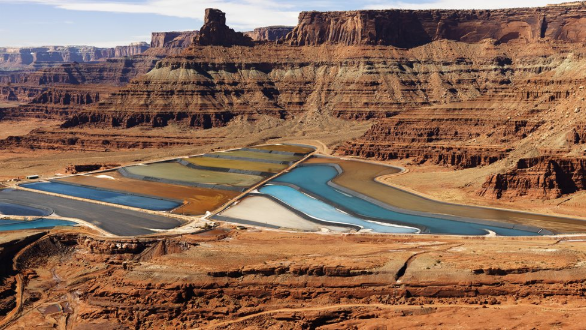
This brings us back to the proposal at hand. Water dredge mining is a form of recreational mining that uses gas-powered dredges to vacuum up rocks, gravel, and sediment from the bottom of creeks and rivers to search for minerals. However, while dredging is an activity that aids regularity in marine traffic, we cannot deny the existence of its shortcomings. Dredging can be a huge threat to the marine environment if left unchecked. The soil deposits in any water-body have a certain pre-disposed composition. By dredging, this composition is altered, causing the existing habitat of creatures and organisms that depends on the original composition of the soil to die out due to the sudden negative changes. In addition, the turbidity of the soil under the water also changes because of the aforementioned change in composition. This leads to the creation of newer and harmful organisms, transferring unwanted organisms to other parts in the water-body which can cause widespread contamination and organic processes by way of releasing extra and unwanted nutrients. However, sometimes dredging can also carry contaminants present in the soil. This leads to harmful particles to regroup and spread to a larger area in the water-body. Dredging loosens up the soil, causing substances that were previously attached to the contaminated deposit to find their way into the water and the un-dredged soil. If the substances are harmful organisms, they will cause substantial degradation to the environment even after dredging the area. Water pollution is another obvious issue and side effect of dredging due to the mixing of soil particles and water.
Despite all of these negative effects, there are ways that we can prevent, or at least minimize, the impacts on both the environment and human health. One way to ensure that the process of dredging is carried out without any detrimental effects is to use the right dredgers. It is important and crucial to use the right one as this may be the catalyst for a less damaged future. For example, the hopper dredgers that suction out the deposits are considered to be a major cause of turbidity in the dredged water-part. It has been recommended that those dredgers which present a chance for pollution and extensive contamination can be avoided and replaced with other safer methodologies. For example, water injection dredging is one of the more environmentally-friendly dredgings solutions. It involves nature itself in the dredging process by using water currents for material transportation. Furthermore, water injection dredging does not involve material removal from the ecosystem.
Now, mine closure and a number of activities to mitigate the impacts of mining are an integral part of all metal mine planning and mineral development from the discovery phase through to closure.
-
- Soil Treatment: High levels of metals in soils and acidity can be harmful to plants, animals, and even humans in some cases. A common approach in dealing with contaminated soil is to move it to specially designed repositories. This method may be expensive and controversial but it is required and necessary. The volume and toxicity of the soil are not reduced, the soil is just relocated. Effective soil treatment approaches in the future depend upon a better understanding of the risks associated with metals in mine wastes, which can include using chemical methods to stabilize metals in soils, making them less mobile and biologically available, using bactericides that stop the bacterial growth that promotes the oxidation of pyrite and the accompanying formation of sulfuric acid, using bio liners such as low permeability and compacted manure as barriers at the base of waste piles, and permanently flooding waste materials containing pyrite to cut off the source of oxygen, stop the development of acidic conditions, and prevent mobilization of metals.
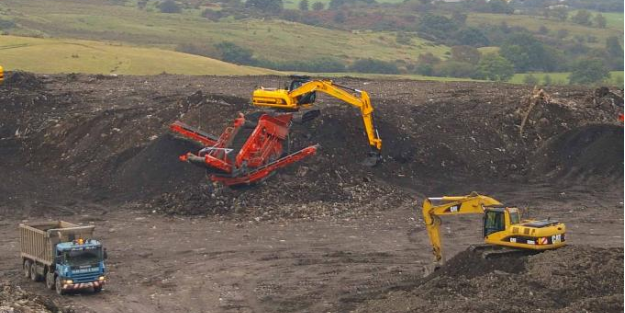
- Water Treatment: The most common treatment for acidic and metal-bearing waters is the addition of a neutralizing material, such as lime, to reduce the acidity. This “active” treatment process, which causes the dissolved metals to precipitate from the water, usually requires the construction of a treatment facility. This method can be expensive due to the requirement of ongoing maintenance. Aside from the expense, some active treatment plants generate large amounts of sludge. Disposal of the sludge is a major problem. Due to the cost and the physical challenges of dealing with sludge, alternatives to active treatment facilities are needed, including using “passive” wetland systems to treat metal-bearing water. This approach has been successfully used where the volumes and acidity of the water are not too great. Passive wetland systems have the added advantage of creating desirable wildlife habitat. Other methods include using in-situ treatment zones where reactive materials or electric currents are placed in the subsurface so that water passing through them would be treated and combining treatment with the recovery of useful materials from contaminated water.

- Prevention of Acid Rock Drainage: Although the discharge of acidic drainage presents several challenges to protecting water quality, the significance and widespread occurrence of acid rock drainage warrant special efforts to prevent or minimize its occurrence. Possible measures to prevent or significantly reduce acid rock drainage include flooding of old underground mine workings to cut off the oxygen supply necessary to the sustained generation of acidic waters, sealing exposed surfaces in underground workings with a coating of material that is non-reactive or impermeable to inhibit the oxidation process, backfilling mine workings with reactive materials that can neutralize and treat waters that pass through them, adding chemicals to the water in flooded surface and underground mine workings that can inhibit acid-generating chemical reactions and precipitate coatings that will seal off groundwater migration routes, and isolating contaminated waters at depth by stratification, allowing viable habitat to develop near the surface in the water that fills large open pits.
Mine Closure
When mining is completed and the minerals are extracted, we will be left with the question of what to do with the mining site. It cannot simply be left abandoned due to the development of legislation in regards to mitigating the impacts of mining and advancing toward a greener future. Therefore, this is where mine reclamation comes in. Mine reclamation is the restoration of landscapes so as to regain its earlier ecological status. Although the process occurs at the end of mining, planning of mine reclamation activities need to be done prior to mining in a region. This helps provide protection and mitigate the adverse environmental effects while improving the aesthetic of the area. While this may require complete reclamation designs, there are simple approaches that are effective. One of them is to add lime or other materials that will neutralize acidity plus a cover of top soil or suitable growth medium to promote vegetation growth. Modifying slopes and other surfaces and planting vegetation as part of the process stabilizes the soil material and prevents erosion and surface water infiltration. Even this simple approach is likely to cost a few thousand dollars per acre to implement. Where soils have a sustained high acidity, the costs of using this approach can increase, sometimes to tens of thousands of dollars per acre. The challenge to find cost-effective reclamation approaches continues.
While it may not be not easy to relocate the waste rock pile and the tailings pond so that they have the least amount of impact possible on the animals, we can rehabilitate them for a better purpose. The tailings pond can be rehabilitated to pasture, plantings, and ponds. To do so, we have to apply a 0.5 metre layer of subsoil material followed by a layer of topsoil, approximately 0.1 metre thick. The upper 0.15 metres of subsoil is modified with lime and superphosphate. The topsoil is fertilized with potassic superphosphate at conventional rates required to ensure successful pasture establishment on these volcanic soils. As required, lime is applied. A standard agricultural seed mix is used. Low ground pressure agricultural machinery is used for soil conditioning and seeding, as opposed to mining machinery that would over compact the soil. The land is grazed by young dry cattle. This allows the previous tailings pond to become a green space. Through various testings, we would then plant native plants on various sections of the new green space. These plants provide a food source and nesting sites for birds, allowing nature to slowly return back. This process here is called waste rock embankments. The result of this process would form pasture plantings and ponds, beneficial for both animals and humans.
Conclusion: Final Words
While this may be expensive, we believe that this is worth the time and money spent. It is in our best interest to see to a bright, clearer, and greener future. With this report, we hope that the Ministry of Energy and Natural Resources of Quebec would see our commitment to better ourselves in a rapidly growing and developing society and cater to the demands of ilmenite resources in an environmentally-friendly manner. No matter what, our company Rock Bottom cares about the conditions of the Earth as it is home to many of us and should be treated with respect and appreciation. In our eyes, to do that would be to utilize its given natural resources while being sensitive to the changes in the environment and geological conditions. We hope that you would consider our proposal carefully and we await to hear your positive response regarding our eco-friendly endeavors in the mining industry.

Remark: This article is written by Pichvorleak Darith for her homework in grade 9 at CIA First International School, Phnom Penh, Cambodia.



